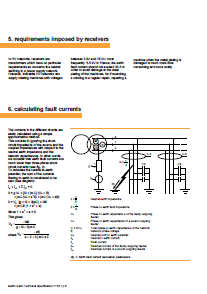Abstract
HV electrical networks can be earthed in different ways. This document analyzes the constraints imposed by the different parameters of the installation (overvoltages, network, receivers) and calculates the fault currents.
Different protection modes are described along with the settings and adjustments suggested according to the requirements.
Introduction
When designing an industrial HV network, a suitable neutral earth arrangement must be selected: the neutral can either be insulated, or it can be connected to earth. The use of an insulated neutral in an HV network has the advantage of ensuring operational continuity since it does not trip on the first fault, however the network capacitance must be such that an earth fault current is not likely to endanger personnel or damage equipment. On the other hand, an insulated neutral implies the following:
- the risk of high overvoltages likely to favourize multiple faults,
- the use of superinsulated equipment,
- compulsory monitoring of the insulation,
- protection against overvoltages, which will become compulsory in the near future,
- the need for complex, selective protection against earth faults which cannot usually be ensured by simple current-measuring relays.
An earthed neutral generally implies mandatory tripping on the first fault, however:
- it reduces overvoltages,
- it provides a simple, reliable, selective means of protection,
- it allows the use of equipment, and in particular cables, with lower insulation levels than for an insulated neutral.
Earthing
The purpose of this study is not to compare the different neutral earth arrangements, but rather, once the neutral earth solution has been adopted, to determine the earthing mode by finding a compromise between three often contradictory requirements:
- to sufficiently damp overvoltages,
- to limit damage and disturbances caused by an earth fault,
- to provide simple, selective protective devices.
Earthing can be of different types:
- direct (without impedance-dependent current limiting),
- through a reactor,
- through a resistor.
Direct earthing
This type of earthing is the most efficient in limiting overvoltages; protection selectivity presents no difficulties. However, in the event of an earth fault, the current is not limited, damage and interference occur and there is considerable danger for the personnel during the time the fault persists. This solution is not used for HV distribution.
AUTHOR: Schneider Electric expert | François SAUTRIAU
| Title: | Neutral earthing in an industrial HV network |
| Format: | |
| Size: | 0.01MB |
| Pages: | 12 |
| Download: | Right here | Video Courses | Membership | Download Updates |


